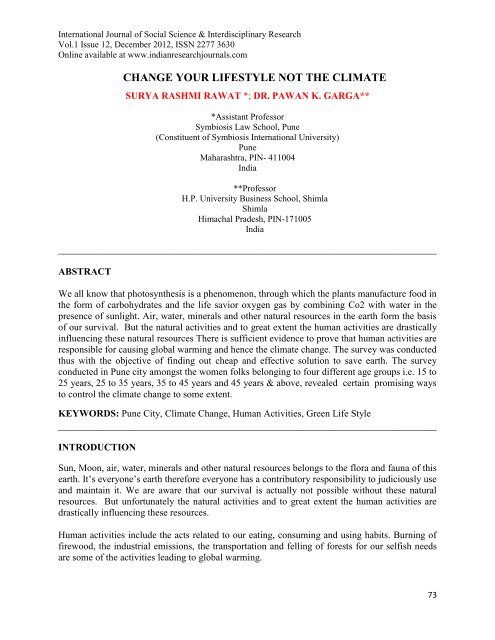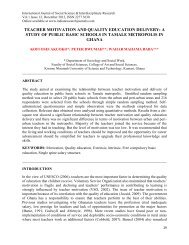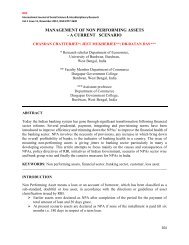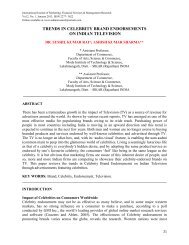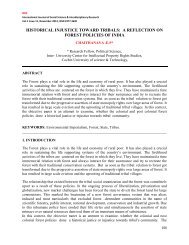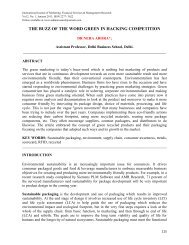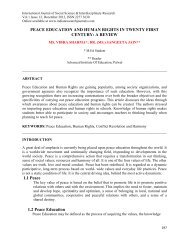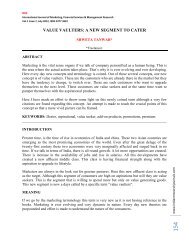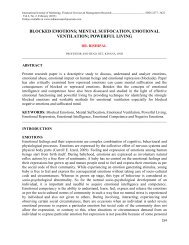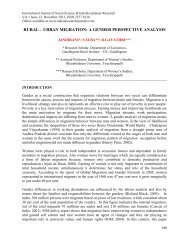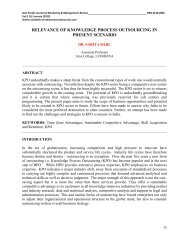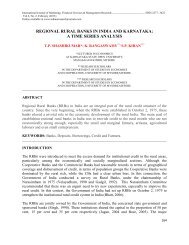change your lifestyle not the climate - Indianresearchjournals.com
change your lifestyle not the climate - Indianresearchjournals.com
change your lifestyle not the climate - Indianresearchjournals.com
Create successful ePaper yourself
Turn your PDF publications into a flip-book with our unique Google optimized e-Paper software.
International Journal of Social Science & Interdisciplinary Research<br />
Vol.1 Issue 12, December 2012, ISSN 2277 3630<br />
Online available at www.indianresearchjournals.<strong>com</strong><br />
CHANGE YOUR LIFESTYLE NOT THE CLIMATE<br />
SURYA RASHMI RAWAT *; DR. PAWAN K. GARGA**<br />
*Assistant Professor<br />
Symbiosis Law School, Pune<br />
(Constituent of Symbiosis International University)<br />
Pune<br />
Maharashtra, PIN- 411004<br />
India<br />
**Professor<br />
H.P. University Business School, Shimla<br />
Shimla<br />
Himachal Pradesh, PIN-171005<br />
India<br />
______________________________________________________________________________<br />
ABSTRACT<br />
We all know that photosyn<strong>the</strong>sis is a phenomenon, through which <strong>the</strong> plants manufacture food in<br />
<strong>the</strong> form of carbohydrates and <strong>the</strong> life savior oxygen gas by <strong>com</strong>bining Co2 with water in <strong>the</strong><br />
presence of sunlight. Air, water, minerals and o<strong>the</strong>r natural resources in <strong>the</strong> earth form <strong>the</strong> basis<br />
of our survival. But <strong>the</strong> natural activities and to great extent <strong>the</strong> human activities are drastically<br />
influencing <strong>the</strong>se natural resources There is sufficient evidence to prove that human activities are<br />
responsible for causing global warming and hence <strong>the</strong> <strong>climate</strong> <strong>change</strong>. The survey was conducted<br />
thus with <strong>the</strong> objective of finding out cheap and effective solution to save earth. The survey<br />
conducted in Pune city amongst <strong>the</strong> women folks belonging to four different age groups i.e. 15 to<br />
25 years, 25 to 35 years, 35 to 45 years and 45 years & above, revealed certain promising ways<br />
to control <strong>the</strong> <strong>climate</strong> <strong>change</strong> to some extent.<br />
KEYWORDS: Pune City, Climate Change, Human Activities, Green Life Style<br />
______________________________________________________________________________<br />
INTRODUCTION<br />
Sun, Moon, air, water, minerals and o<strong>the</strong>r natural resources belongs to <strong>the</strong> flora and fauna of this<br />
earth. It’s everyone’s earth <strong>the</strong>refore everyone has a contributory responsibility to judiciously use<br />
and maintain it. We are aware that our survival is actually <strong>not</strong> possible without <strong>the</strong>se natural<br />
resources. But unfortunately <strong>the</strong> natural activities and to great extent <strong>the</strong> human activities are<br />
drastically influencing <strong>the</strong>se resources.<br />
Human activities include <strong>the</strong> acts related to our eating, consuming and using habits. Burning of<br />
firewood, <strong>the</strong> industrial emissions, <strong>the</strong> transportation and felling of forests for our selfish needs<br />
are some of <strong>the</strong> activities leading to global warming.<br />
73
International Journal of Social Science & Interdisciplinary Research<br />
Vol.1 Issue 12, December 2012, ISSN 2277 3630<br />
Online available at www.indianresearchjournals.<strong>com</strong><br />
We <strong>the</strong> citizens of earth must realize that our consumption pattern castes heavy impact over<br />
earth. Let’s start with <strong>the</strong> basic necessity of our life <strong>the</strong> water, what do we do with <strong>the</strong> empty<br />
plastic bottles after consuming mineral water inside it? Have we ever thought of <strong>the</strong> fate of<br />
plastic or poly<strong>the</strong>ne packaging that we throw anywhere and everywhere? Look at <strong>the</strong> sides of<br />
railway tracks, <strong>the</strong> local nullas in <strong>the</strong> urban areas! What is it that is adding heaps over heaps of<br />
<strong>the</strong> garbage? Yes, you guess it right it’s <strong>the</strong> poly<strong>the</strong>ne bag and <strong>the</strong> o<strong>the</strong>r like packaging material<br />
which we know is <strong>not</strong> biodegradable in nature.<br />
Despite <strong>the</strong> fact that we all are aware that dumping poly<strong>the</strong>ne waste is <strong>not</strong> good for <strong>the</strong> health of<br />
earth due to its non-biodegradable nature, we continue <strong>not</strong> only to use it but also to dump it<br />
carelessly.<br />
Review of Literature<br />
Climate Change and Consequences<br />
Alexander, L. V., et al. (2006)1, empirically established <strong>the</strong> fact that <strong>the</strong>re was a significant<br />
<strong>change</strong> in <strong>climate</strong> from 1951–1978 and from 1979–2003.The report based on 10 measurable<br />
planet-wide features used to measure global temperature <strong>change</strong>s revealed that <strong>the</strong> past decade<br />
was <strong>the</strong> warmest on record with <strong>the</strong> Earth gradually growing warmer over <strong>the</strong> last 50 years<br />
(Arndt, et. al, 2010)2.<br />
According to <strong>the</strong> World Health Organization, WHO (2010) report, even a 1 o C increase in<br />
global temperature above pre-industrial levels could double annual deaths from <strong>climate</strong> <strong>change</strong><br />
to at least 300,000.<br />
Cause of Climate Change<br />
According to NASA’s Earth Observatory (2010)3Human activity has caused an imbalance in <strong>the</strong><br />
natural cycle of <strong>the</strong> greenhouse effect and related processes. Arndt, Baringer and Johnson,<br />
(2010)4 too indicated a distinct human fingerprint on <strong>climate</strong> <strong>change</strong>.<br />
Adding to <strong>the</strong> trauma, Tushar K Savale, et. al. (2012) 5 observed that <strong>the</strong> buyers are<br />
unintentionally contributing to <strong>the</strong> environmental degradation by purchasing things that are<br />
harvested, made, or used in environmentally unsafe ways.<br />
1 Alexander, L. V., et al. (2006), Global observed <strong>change</strong>s in daily <strong>climate</strong> extremes of temperature and precipitation, J. Geophys. Res., 111,<br />
D05109, doi: 10.1029/2005JD006290. Pp18, 19.<br />
2 Arndt, D. S., M. O. Baringer, and M. R. Johnson, Eds., 2010: State of <strong>the</strong> Climate in 2009. Bull. Amer. Meteor. Soc., 91 (7), S1–S224.<br />
3The Carbon Cycle; The Human Role, Earth Observatory, NASA ,July 28, 2010 at http://www.earthobservatory.nasa.gov<br />
4 Arndt, D. S., M. O. Baringer, and M. R. Johnson, Eds., 2010: State of <strong>the</strong> Climate in 2009. Bull. Amer. Meteor. Soc., 91 (7), S1–S224.<br />
5 Tushar K Savale, Anil F Sharma and Prabodhan U Patil (2012). Article: Green Marketing: Opportunities And Challenges. IJCA Proceedings on<br />
International Conference in Computational Intelligence (ICCIA2012)iccia(4):-, March 2012. Published by Foundation of Computer Science, New<br />
74
International Journal of Social Science & Interdisciplinary Research<br />
Vol.1 Issue 12, December 2012, ISSN 2277 3630<br />
Online available at www.indianresearchjournals.<strong>com</strong><br />
Ecological Attitude and Buyer Behavior<br />
Lately with awareness of <strong>climate</strong> <strong>change</strong> people have developed ecological attitude but<br />
surprisingly <strong>the</strong>re is a difference between <strong>the</strong> ecological attitude and <strong>the</strong> real purchasing<br />
behaviour. Donaldson (2005) 6 identified strong faith of consumers over <strong>the</strong> existing<br />
conventional brands than <strong>the</strong> “green claims” of <strong>com</strong>panies as a possible reason for this gap. Jain<br />
and Kaur, (2006) 7 also observed <strong>the</strong> similar reason and also <strong>the</strong> lack of awareness as a cause for<br />
this gap. Singh S. D. (2011) 8 after five years too reported lack of information & mainly <strong>the</strong><br />
skeptical attitude towards green claims as reasons for this lag.<br />
According to Mohanasundaram V. (2012) 9 , Green Marketing is about, regarding <strong>the</strong> consumers<br />
concern towards conservation of natural environment. Conservation of natural environment<br />
could be achieved in different ways. The <strong>change</strong> in life style and behavior of consumer’s can<br />
make a lot of difference.<br />
The way we react and interact with <strong>the</strong> living & nonliving things and <strong>the</strong> way we live constitutes<br />
what we call our Life style. Now <strong>the</strong> word Life style again is much wider in meaning including<br />
<strong>the</strong> way we eat, drink, dress up, talk, walk, use things and behave in our day today life.<br />
Unknowingly our acts are contributing towards environmental degradation.<br />
As defined by me in my o<strong>the</strong>r research paper titled, “ Combating <strong>climate</strong> <strong>change</strong> through green<br />
<strong>lifestyle</strong>,” “The process of Buying, Behaving, & Bowing only before green so as to minimize <strong>the</strong><br />
carbon foot print and maximize <strong>the</strong> carbon neutralizing effect is what constitutes <strong>the</strong> Green<br />
Lifestyle.”<br />
The review of literature in this subject amply supports <strong>the</strong> fact that many consumers are <strong>not</strong><br />
satisfied with <strong>the</strong> green marketing; many of <strong>the</strong>m have <strong>not</strong> yet started using it. In such a scenario<br />
where consumers are ei<strong>the</strong>r <strong>not</strong> aware or are <strong>not</strong> using green products due to <strong>the</strong>ir skepticism<br />
towards <strong>the</strong> green claims along with <strong>the</strong> excessive prices associated to <strong>the</strong>m, <strong>the</strong> question arises<br />
as to how do we neutralize <strong>the</strong> impact of carbon foot print released by anthropogenic activities?<br />
Do we have any cheap and reliable way to save our earth?<br />
York, USA<br />
6 Donaldson, R. H. (2005), “Green brands”, NZ Marketing Magazine, 24(8), 14–17.<br />
7 Jain, S.K. and Kaur, G. (2006), “Role of Socio-Demographics in Segmenting and Profiling Green Consumers: An Exploratory Study of<br />
Consumers in India”, Journal of International Consumer Marketing, 18(3), 107-146.<br />
8 Singh S. D. (2011), “A Study Of Consumer Behavior Of Elderly Consumers With Special Reference To Green Products”,<br />
International Journal of Management & Information Systems – Fourth Quarter 2011 Volume 15, Number 4<br />
9 Mohanasundaram V. (2012), “Green Marketing – Challenges And Opportunities,” ZENITH International Journal of Multidisciplinary Research<br />
Vol.2 Issue 4, April 2012, ISSN 2231 5780 at www.zenithresearch.org.in<br />
75
International Journal of Social Science & Interdisciplinary Research<br />
Vol.1 Issue 12, December 2012, ISSN 2277 3630<br />
Online available at www.indianresearchjournals.<strong>com</strong><br />
Looking at <strong>the</strong> above definition of green <strong>lifestyle</strong>, we see that this skeptical attitude reduces <strong>the</strong><br />
possibility of first “B” i.e. Buying. The secondB ie Bowing before green does <strong>not</strong> take place in an<br />
environment where people do <strong>not</strong> rely much <strong>the</strong> green claims. In such a scenario <strong>the</strong> only option<br />
that can sail us out of this bad wea<strong>the</strong>r is <strong>the</strong> third B i.e.Behaving Green.<br />
Objectives of <strong>the</strong> Study<br />
The objective of this paper is to find out a cheap and effective solution to save earth and also to<br />
find out as to what percentage of population is ready to accept it.<br />
Research Methodology<br />
The research is based on primary data, collected and collated through a survey from over a<br />
sample of 200 working women in Pune, Maharashtra India. The respondents were selected<br />
through stratified sampling method. Data was collected through a questionnaire and in depth<br />
interviews with <strong>the</strong> sample including Executives, Academicians and BPO Workers belonging to<br />
four different Age groupsi.e. 15 years to 25 years, 25 years to 35 years 35 years to 45 years and<br />
45 years & above.<br />
Secondary data in <strong>the</strong> form of articles published in books, journals, magazines, research papers,<br />
newspapers and reports were also incorporated.<br />
Limitation<br />
The research being empirical one was based on a survey conducted through questionnaire.<br />
People were <strong>not</strong> ready to fill up <strong>the</strong> responses <strong>the</strong>y had to be convinced for <strong>the</strong> same. O<strong>the</strong>r<br />
major problem was <strong>the</strong> lack of awareness of population about <strong>the</strong> research topic. Therefore <strong>the</strong><br />
topic had to be explained first to <strong>the</strong> majority of population.<br />
Findings<br />
I st Age Group 15 to 25 years<br />
In this age group hundred percent of <strong>the</strong> population agreed to <strong>the</strong> idea of planting trees as a<br />
measure to save earth. Eighty one percent of population agreed to “say no to use of poly bags” in<br />
future. Sixty three percent agreed to maintain local rivers in <strong>the</strong> surroundings. Eighty one percent<br />
agreed to use bicycle in future for local trips so as to minimize <strong>the</strong> pollution. Ninety one percent<br />
consented to have stringent laws to prevent environmental degradation.<br />
II nd Age Group 25 to 35 years<br />
In this age group hundred percent of <strong>the</strong> population agreed to <strong>the</strong> idea of planting trees as a<br />
measure to save earth. Eighty seven percent of population agreed to “say no to use of poly bags”<br />
in future. Sixty seven percent agreed to maintain local rivers in <strong>the</strong> surroundings. Ninety five<br />
percent agreed to use bicycle in future for local trips so as to minimize <strong>the</strong> pollution. Ninety<br />
seven percent consented to have stringent laws to prevent environmental degradation.<br />
76
International Journal of Social Science & Interdisciplinary Research<br />
Vol.1 Issue 12, December 2012, ISSN 2277 3630<br />
Online available at www.indianresearchjournals.<strong>com</strong><br />
III rd Age Group 35 to 45 years<br />
Here also hundred percent of <strong>the</strong> population agreed to <strong>the</strong> idea of planting trees as a measure to<br />
save earth. Eighty two percent of population agreed to “say no to use of poly bags” in future.<br />
Forty seven percent agreed to maintain local rivers in <strong>the</strong> surroundings. Ninety two percent<br />
agreed to use bicycle in future for local trips so as to minimize <strong>the</strong> pollution. Ninety four percent<br />
consented to have stringent laws to prevent environmental degradation.<br />
IV th Age Group more than 45 years<br />
In this age group hundred percent of <strong>the</strong> population agreed to <strong>the</strong> idea of planting trees as a<br />
measure to save earth. Fifty four percent of population agreed to “say no to use of poly bags” in<br />
future. Forty two percent agreed to maintain local rivers in <strong>the</strong> surroundings. Sixty three percent<br />
agreed to use bicycle in future for local trips so as to minimize <strong>the</strong> pollution. Eighty six percent<br />
consented to have stringent laws to prevent environmental degradation.<br />
Figure 1:Saving Earth by Changing Life Style<br />
77
International Journal of Social Science & Interdisciplinary Research<br />
Vol.1 Issue 12, December 2012, ISSN 2277 3630<br />
Online available at www.indianresearchjournals.<strong>com</strong><br />
Discussion<br />
Analysis of data proves beyond doubts that hundred percent of <strong>the</strong> population irrespective of<br />
<strong>the</strong>ir age group is ready to go in for planting green trees as a measure to save earth.<br />
Regarding use of poly<strong>the</strong>ne bags, no significant difference was observed in <strong>the</strong> responses of first<br />
three age groups. In <strong>the</strong> fourth age group i.e. people over 45 years only 56percent agreed to say<br />
no to <strong>the</strong> use of poly<strong>the</strong>ne bags. In fact a significant chunkquestioned <strong>the</strong> way <strong>the</strong> products like<br />
milk, ghee, various consumer goods and <strong>the</strong> o<strong>the</strong>r ready to use products be marketed in <strong>the</strong><br />
absence of poly<strong>the</strong>ne bags.<br />
Worst of <strong>the</strong> responses were recorded for <strong>the</strong> question on maintenance of rivers. Probably people<br />
do <strong>not</strong> consider it as <strong>the</strong>ir responsibility to save depleting rivers and local nullas. It seems as if<br />
according to <strong>the</strong>m saving & revive <strong>the</strong> dying nullas is <strong>not</strong> <strong>the</strong>ir but <strong>the</strong> government’s<br />
responsibility. The first two age groups were still better with sixty three and sixty seven percent<br />
of <strong>the</strong>m agreeing to maintain and revive rivers. The last two age groups seemed really averse to<br />
<strong>the</strong> whole idea with a mere forty seven and forty two percent only agreeing to go in for revival of<br />
dying local rivers.<br />
The question on enacting and strictly implementing <strong>the</strong> strong laws for saving earth garnered <strong>the</strong><br />
support of majority of population with ninety one, ninety two , ninety four and eighty six<br />
percent voting in its favor.<br />
Does this mean that to <strong>the</strong> present day citizens of earth, saving earth is more <strong>the</strong> responsibility of<br />
government? Because on <strong>the</strong> issues like planting trees, and using bicycle that affected <strong>the</strong>ir<br />
health along with <strong>the</strong> health of earth <strong>the</strong>y seemed quite positive to take an initiative. But <strong>the</strong><br />
issues only affecting <strong>the</strong> health of earth like saying no to polybags, maintaining local rivers saw<br />
<strong>com</strong>paratively lukewarm responses.<br />
Conclusion<br />
From <strong>the</strong> research in hand we conclude that <strong>the</strong> population sees health of people and planet as<br />
two separate issues. For <strong>the</strong>m saving earth is more <strong>the</strong> responsibility of government than that of<br />
citizens. But yes, <strong>the</strong> issues which <strong>the</strong>y consider directly affect <strong>the</strong>ir health are what matter <strong>the</strong>m<br />
<strong>the</strong> most and <strong>the</strong>y are eager to take steps towards keeping it fit.<br />
One important point to <strong>not</strong>e here is <strong>the</strong> fact that people from fifteen to thirty five years of age<br />
flared really well <strong>not</strong> only on <strong>the</strong> issues concerning <strong>the</strong>ir health but also that of <strong>the</strong> health of<br />
earth.<br />
Being born and brought up in <strong>the</strong> partially socialist economy, <strong>the</strong> expectation of citizens are too<br />
high from <strong>the</strong> government, that’s why majority of <strong>the</strong>m agreed strongly for having stringent law<br />
for saving earth.<br />
78
International Journal of Social Science & Interdisciplinary Research<br />
Vol.1 Issue 12, December 2012, ISSN 2277 3630<br />
Online available at www.indianresearchjournals.<strong>com</strong><br />
Re<strong>com</strong>mendations<br />
The business houses and government must understand one thing that <strong>the</strong> citizens consider health<br />
of people and that of planet as two separate issues. The issue which <strong>the</strong>y consider directly saves<br />
<strong>the</strong>ir health or saves <strong>the</strong>ir health in addition to saving <strong>the</strong> earth is what matters <strong>the</strong>m. Something<br />
only meant for saving earth does <strong>not</strong> appeal <strong>the</strong>m. According to research, people assume saving<br />
earth to be government’s responsibility.<br />
In this scenario spreading awareness and making people understand <strong>the</strong> fact that <strong>the</strong>ir health is<br />
directly connected to <strong>the</strong> health of planet is must and is bound to show good results.<br />
To sum up, Healthy Planet means Healthy People and Healthy People fur<strong>the</strong>r need Healthy<br />
Planet for <strong>the</strong>m and <strong>the</strong>ir generations to survive without any mutation.<br />
References<br />
Journals<br />
Alexander, L. V., et al. (2006), Global observed <strong>change</strong>s in daily <strong>climate</strong> extremes of<br />
temperature and precipitation, J. Geophys. Res., 111, D05109, doi: 10.1029/2005JD006290.<br />
Pp18, 19.<br />
Arndt, D. S., M. O. Baringer, and M. R. Johnson, Eds., 2010: State of <strong>the</strong> Climate in 2009. Bull.<br />
Amer. Meteor. Soc., 91 (7), S1–S224.<br />
Donaldson, R. H. (2005), “Green brands”, NZ Marketing Magazine, 24(8), 14–17.<br />
Jain, S.K. and Kaur, G. (2006), “Role of Socio-Demographics in Segmenting and Profiling<br />
Green Consumers: An Exploratory Study of Consumers in India”, Journal of International<br />
Consumer Marketing, 18(3), 107-146.<br />
1 Mohanasundaram V. (2012), “Green Marketing – Challenges And Opportunities,” ZENITH<br />
International Journal of Multidisciplinary Research Vol.2 Issue 4, April 2012, ISSN 2231 5780<br />
at www.zenithresearch.org.in<br />
Singh S. D. (2011), “A Study Of Consumer Behavior Of Elderly Consumers With Special<br />
Reference To Green Products”,International Journal of Management & Information Systems –<br />
Fourth Quarter 2011 Volume 15, Number 4<br />
Articles<br />
The Carbon Cycle; The Human Role, Earth Observatory, NASA ,July 28, 2010 at<br />
http://www.earthobservatory.nasa.gov<br />
79
International Journal of Social Science & Interdisciplinary Research<br />
Vol.1 Issue 12, December 2012, ISSN 2277 3630<br />
Online available at www.indianresearchjournals.<strong>com</strong><br />
Proceedings<br />
Tushar K Savale, Anil F Sharma and Prabodhan U Patil (2012). Article: Green Marketing:<br />
Opportunities And Challenges. IJCA Proceedings on International Conference in Computational<br />
Intelligence (ICCIA2012)iccia(4):-, March 2012. Published by Foundation of Computer Science,<br />
New York, USA.<br />
Websites<br />
www.earthobservatory.nasa.gov<br />
www.zenithresearch.org.in<br />
80


